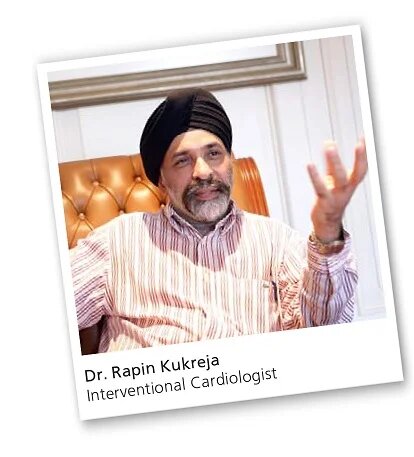Taking Care Of Your Heart – The Sooner The Better
Heart attack
“After having lunch, Ladda felt some discomfort in her stomach. She did not take it too seriously, assuming that it was simply indigestion. She continued walking, hoping that the symptoms would go away. The discomfort also was felt in the middle of her chest made her stopped walking. After a while, the pressure got stronger to the point that it became painful, the pain quickly spreading to her arm and jaw. Ladda was having a heart attack.”
What happened to Ladda can happen to any of us. When heart disease develops, we often don’t know anything about it until the symptoms emerge. Chest pain is one of them.
Heart attacks are a leading killer among both men and women all over the world. But fortunately, today there are excellent treatments for heart attacks that can save lives and prevent the disabilities that often ensue.
What is chest pain and how does it develop?
Chest pain is an important symptom of heart disease that might eventually lead to a heart attack. It most often occurs as a result of a condition called coronary artery disease or CAD. Dr. Rapin Kukreja, an Interventional Cardiologist at Bangkok Heart Hospital, elaborated on the underlying problems of this deadly disease.
“Looking back 20 years, CAD is much more common now. The change in lifestyle and diet has an important role to play in this upward spiral. Today, CAD strikes the adult population all over the world and Thailand is no exception,” Dr. Rapin said. CAD implies narrowing of one or more of the arteries that supply blood and oxygen to the heart muscle. Most of the time it is due to the accumulation of plaque, a deposit of cholesterol or other fat cells that builds up on the artery walls. Over time, it eventually clogs the arteries, “Dr. Rapin added. When a blockage becomes large enough, it can partly or near completely block the flow of oxygen-rich blood to part of the heart muscle and chest pain and feelings of tightness are likely to occur.
When do the symptoms appear?
As to when the symptoms occur, that is a tricky questions, said Dr. Rapin. “It varies from person to person. When an artery is narrowed by 50-70% or more, that is the point at which the disease becomes clinically significant. At this point, people may experience chest pain or chest tightness particularly with activities or exertion.
Coronary artery disease (CAD)
“Once people experience chest pain, it means the disease has progressed far enough to the point of producing symptoms. This pain is called angina (angina pectoris), a condition where the heart needs more blood supply than it is getting.
As much as 20% population will have some degree of CAD in their life time. Symptoms include chest pain, shortness of breath and a feeling of discomfort that show up with exertion, especially during exercise, running or climbing up long flights of stairs. When the sufferer is resting, the symptoms disappear. In typical angina cases, patients will experience pain with radiation, where the pain starts in the middle of the chest and radiates out to the throat, thus giving a choking sensation. Advanced symptoms include pain that either radiates to the left, right or both shoulders then continues to the arms. Some will experience stiffness/heaviness of the jaw and in unusual cases, a pain at the back of the neck and ears.
Saving life

“Patients who experience prolonged chest pain that is much more severe than before. They may also have difficulty breathing and they may sweat profusely. These are signs of a heart attack due to severe shortage of blood supply due to an advanced or completely artery blockage that can damage the heart muscles. They need immediate help. With an acute heart attack, timing is all important. If you can get your artery open as soon as possible, the chance of saving a large portion of the heart muscles is much higher than if there is a delay”, explained Dr. Rapin.
The most damaging type of heart attack called STEMI (ST Elevation Myocardial Infarction). There are few treatment approaches to open the occluded artery as soon as possible. One approach may be carried out in the hospital that equip with cardiac catheterization service 24/7. For the best result, the occluded artery should be opened by balloon (with or without stent) within 90 minutes after the diagnosis is made. This procedure called angioplasty or PCI (Percutaneous Coronary Intervention).
The longer time to treat the more damage of the heart muscle. Another approach, in the hospitals that do not have cardiac catheterization lab, is giving thrombolytic agent (medicine to help dissolve blood clot that cause occlusion of the artery) within 30 minutes after the diagnosis is made. The result is not as good as quickly opening the occluded artery with the angioplasty or PCI approach but it is the only choice available at that hospital.
The third approach is to combine the first 2 approaches. When the patient is admitted to the hospital that has no cardiac catheterization service, the thrombolytic agent should be given quickly (if there is no contraindication). The arrangement should be made to transfer that patient to the hospital that has cardiac catheterization lab (with 24/7 and expertise service) for coronary angiogram and possibility performing balloon/stent procedure in 3 hours up to 24 hours after the thrombolytic treatment.
Other type of heart attack is the NSTEMI (Non ST Elevation Myocardial Infarction). The treatment is different from the STEMI particularly the less urgency of opening up the clogged artery. Thrombolytic agents should not be used. Treatment can be medical or angioplasty/PCI depend on estimated risk of outcome. The higher the risk of unfavorable outcome the sooner the angioplasty/stent should be performed.
What is coronary artery ballooning?
Formally known as coronary angioplasty, cardiac ballooning involves inserting a balloon-tipped catheter through an artery in the groin or arm and making its way through to enlarge a narrowing of a coronary artery. Angioplasty is successful in opening coronary arteries in well over 90% of patients. However, patients who undergo successful coronary angioplasty can develop recurrent narrowing at the site of the original balloon inflation in the future.
A healthy heart depends on you!
“Once plaque has built up inside artery walls, it is permanent. It is wrong to think that the deposits starts late in life, let’s say in your 40’s or 50’s. The symptoms that appears in your 40’s or 50’s are because of well advanced disease, said Dr. Rapin.
This deposit of cholesterol or fat cells starts in late teens. Therefore, ideal prevention in terms of cardiology should start in your teens.
When you consider the risk factors, the only things that you cannot modify are your sex, age and genetic profile. The rest is behavioral conditioning, involving high blood pressure, high cholesterol, stress, sedentary lifestyle, diabetes, being overweight, obesity, smoking, lack of exercise, etc. all of which you can modify.
To strengthen your heart muscles, you should exercise for at least 30-40 minutes, at least five-six days a week. The exercise should be aerobics that can raise your heart rate to about 120 beats per minute, Dr. Rapin advised.
“I would much rather have my patients call in just to say “hello” than to complain of chest pain”. Dr. Rapin said smilingly before signing off.






